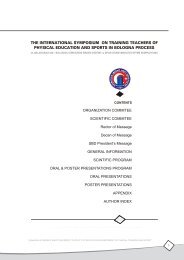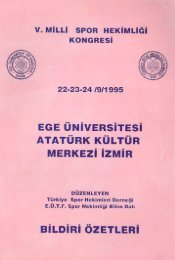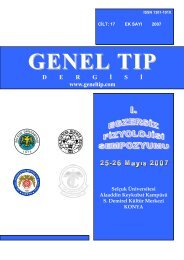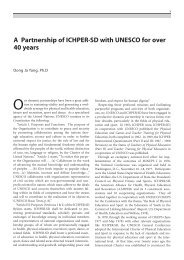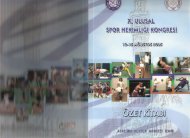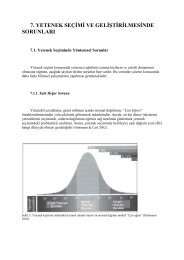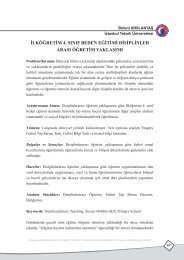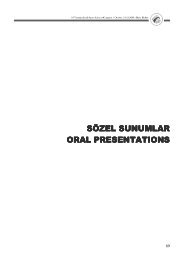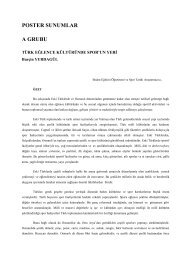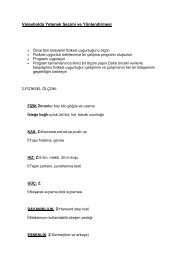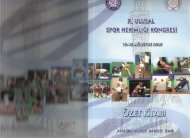KARDÄ°YORESPÄ°RATUVAR EGZERSÄ°Z TESTLERÄ° ... - Spor Bilim
KARDÄ°YORESPÄ°RATUVAR EGZERSÄ°Z TESTLERÄ° ... - Spor Bilim
KARDÄ°YORESPÄ°RATUVAR EGZERSÄ°Z TESTLERÄ° ... - Spor Bilim
You also want an ePaper? Increase the reach of your titles
YUMPU automatically turns print PDFs into web optimized ePapers that Google loves.
7.ULUSLARARASI SPOR BİLİMLERİ KONGRESİ27-29 EKİM 2002KONGRE - PANELLER4. Fitness RequirementsThe fitness requirements for football depend on the level of performance, positional role and styles ofplay. They vary also with age groups, between men and women, and at different stages of the playing season.Re-acquiring desirable fitness levels is especially important after injury, prior to returning to competitive play.Otherwise the individual is vulnerable to re-injury if uncorrected weaknesses, in muscle strength for example,are carried into a game.The main recommendations for fitness assessment are as follows:-Fitness demands of soccer are related to the technical and physical aspects of the game. This resultsin a combination of demands being imposed on the player during competition.As a result of these demands, tests with a high degree of specificity to soccer should be mployed forthe assessment of performance.Attempts to improve fitness levels are reflected in the training programmes in which players engage.Training loads can vary according to the day of the week and the stage of the season. A typical weekly cycle of―recovery-peak loading-taper‖ needs to be altered when matches are scheduled for mid-week as well as atweek-end. Emphasis on different fitness aspects also changes with seasonal phase, according to the principlesof periodised training.The energy expended during the daily habitual activities of professional soccer players represents theoverall occupational strain. There are also implications for dietary requirements and the intake of energy. Thedata included in Table 2 do not indicate inordinately high levels of daily energy expenditure and suggest thattraining may be regulated to avoid over-reaching. The main requirement seems to be for the right balance ofmacronutrients in the diet, the emphasis on carbohydrate being recognised (Shephard and Leatt, 1987).Table 2. Mean daily energy expenditure in professional soccer players.Authors Methods Energy expended (kJ.d -1 )Reilly and Thomas (1979)Diary cardsHeart rateMotion analysis14.44Ebine et al. (2002) Doubly labelled water 14.85. Laboratory StudiesThe intermittent and acyclical nature of activity during competition means that it is difficult to model gamerelatedprotocols in laboratory experiments concerned with soccer. Nevertheless, there have been creativeprotocols for isolating football-related questions and studying these in experimental conditions. One example isthe use of a shuttle-run at an intensity corresponding to that of match-play for a duration of 75 min. An ensuingtest to exhaustion allows the investigation of mechanisms related to fatigue or ways of offsetting it (Nicholas etal., 2000). An alternative protocol is to mimic the cycles that are typical of activity in match-play, with the subjectexercising on a treadmill. Two 45-min periods are separated by a 15-min rest to simulate football conditions(Drust et al., 2000). If a non-motorised treadmill is employed, the sprint component of the protocol may be allout,whilst power output can be monitored. In this way the effectiveness of creatine (or carbohydrate) forfootball performance can be investigated.It is likely that field studies with a greater specificity to the game will be employed more in futureinvestigations of the physiology of soccer. The work-rate and activity profiles can be used to design appropriatetraining protocols to optimise fitness and ensure that performance during play is enhanced. Whilst physiologicalconsiderations have a place in a systematic preparation for competition, performance ultimately depends on thequality with which individual skills and team tactics are executed.357



